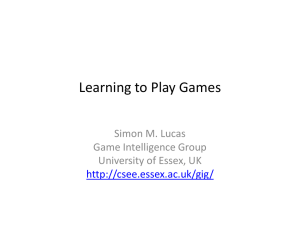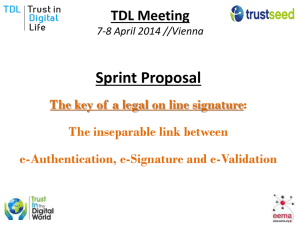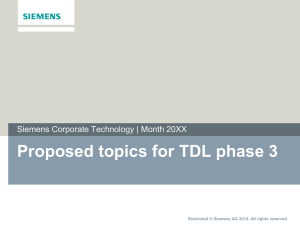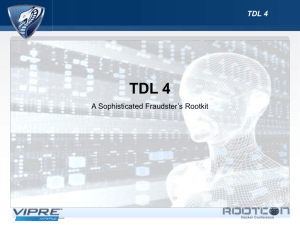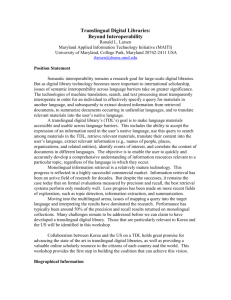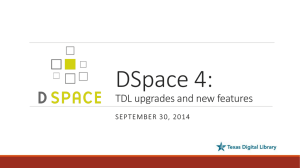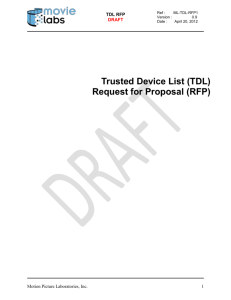Database Application Development as n Object Modeling Activity
advertisement
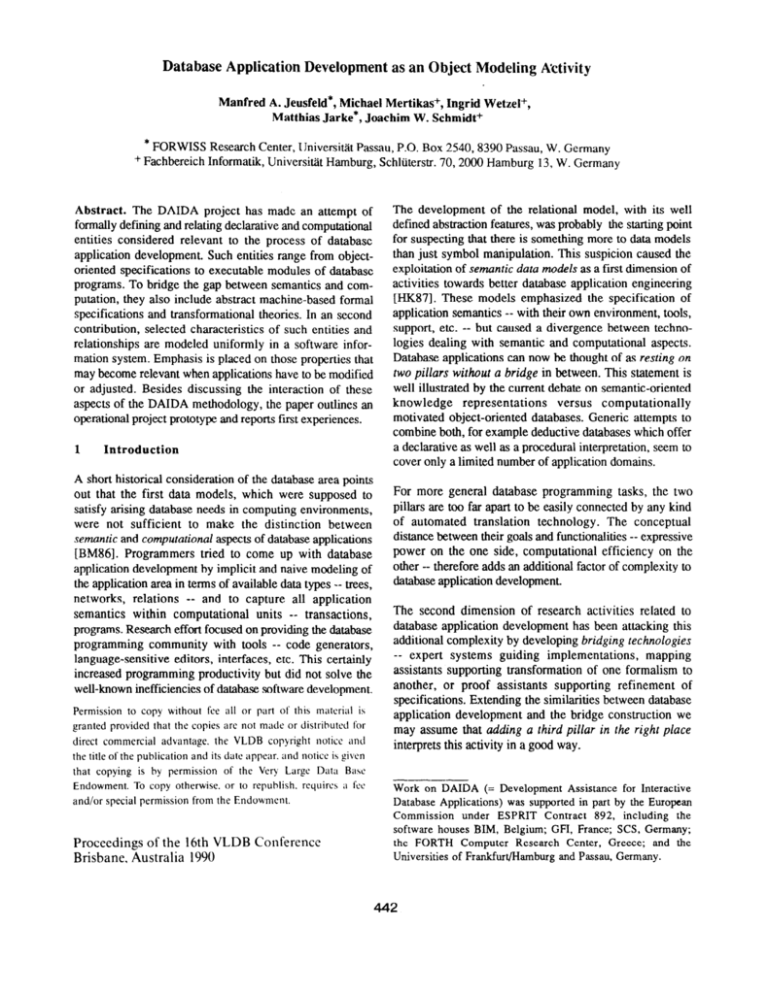
Database Application Development as an Object Modeling Activity
Manfred A. Jeusfeld*, Michael Mertikas+, Ingrid Wetzel+,
Matthias Jarke*, Joachim W. Schmidt+
* FORWISS ResearchCenter, Universitit Passau,P.O. Box 2540,839O Passau,W. Germany
+Fachbereich Informatik, Universitit Hamburg, Schliiterstr. 70,200O Hamburg 13, W. Germany
Abstract. The DAIDA project has made an attempt of
formally defining and relating declarative and computational
entities considered relevant to the process of database
application development. Such entities range from objectoriented specifications to executable modules of database
programs. To bridge the gap between semanticsand computation, they also include abstract machine-basedformal
specifications and transformational theories. In an second
contribution, selected characteristics of such entities and
relationships are modeled uniformly in a software information system. Emphasis is placed on those properties that
may becomerelevant when applications have to be modified
or adjusted. Besides discussing the interaction of these
aspectsof the DAIDA methodology, the paper outlines an
operationalproject prototype and reports first experiences.
1
Introduction
A short historical consideration of the databasearea points
out that the first data models, which were supposed to
satisfy arising databaseneeds in computing environments,
were not sufficient to make the distinction between
semantic and computational aspectsof databaseapplications
[BM86]. Programmers tried to come up with database
application development by implicit and naive modeling of
the application areain terms of available data types -- trees,
networks, relations -- and to capture all application
semantics within computational units -- transactions,
programs.Researcheffort focusedon providing the database
programming community with tools -- code generators,
language-sensitive editors, interfaces, etc. This certainly
increased programming productivity but did not solve the
well-known inefficiencies of databasesoftwaredevelopment.
permission
to copy without
granted provided
direct commercial
advantage.
the title of the publication
that copying
fee all or part of this material
that the copies are not made or distributed
the VLDB
copyright
notice
is
for
and
The development of the relational model, with its well
defined abstractionfeatures,was probably the starting point
for suspecting that there is something more to data models
than just symbol manipulation. This suspicion caused the
exploitation of semantic data modelsas a first dimension of
activities towards better databaseapplication engineering
[HK87]. These models emphasized the specification of
application semantics-- with their own environment, tools,
support, etc. -- but caused a divergence between technologies dealing with semantic and computational aspects.
Databaseapplications can now be thought of as resting on
two pillars without a bridge in between. This statementis
well illustrated by the current debate on semantic-oriented
knowledge representations versus computationally
motivated object-oriented databases.Generic attempts to
combine both, for example deductive databaseswhich offer
a declarative as well as a procedural interpretation, seemto
cover only a limited number of application domains.
For more general database programming tasks, the two
pillars are too far apart to be easily connectedby any kind
of automated translation technology. The conceptual
distancebetweentheir goals and functionalities -- expressive
power on the one side, computational efficiency on the
other -- therefore adds an additional factor of complexity to
databaseapplication development.
The second dimension of research activities related to
databaseapplication development has been attacking this
additional complexity by developing bridging technologies
-- expert systems guiding implementations, mapping
assistants supporting transformation of one formalism to
another, or proof assistants supporting refinement of
specifications. Extending the similarities between database
application development and the bridge construction we
may assume that adding a third pillar in the right place
interprets this activity in a good way.
and its date appear. and notice is given
is by permission
of the Very Large
Endowment. To copy otherwise. or to republish.
and/or special permission from the Endowmenr.
Data
Base
requires
a fee
Proceedings of the 16th VLDB Conference
Brisbane, Australia 1990
---Work on DAIDA (= Development Assistance for Interactive
Database Applications) was supported in part by the European
Commission under ESPRIT Contract 892, including the
software houses BIhI, Belgium; GFI, France; SCS, Germany;
the FORTH Computer Research Center, Greece; and the
Universities of Frankfurt/Hamburg and Passau, Germany.
442
In section 3, we present part of the second dimension
activities: how to bridge the semantic and the implementation layer. We start from predicative object-oriented
descriptions, a technology supporting attractive abstraction
principles and concise notation. We transform these
specifications into an intermediate structure of Abstract
Machines and proceed with formal refinement down to
efficient transaction-orienteddatabaseprograms.
In section 4, we enter the third dimension of activities by
explaining how to describe abstractly system components
and their dependencies; also, how to make use of this
information. Section 5 describes the actual tools the
DAIDA environment offers for mapping support and
software information management, and presents a more
generalprocessmodel basedon this experience.
2
Two DAIDA
Application
Views
of a Data-Intensive
Taking for granted the necessity of a semantic layer
addressingexpressivepower and reasoningcapabilities and
of a computational layer addressing computational
efficiency, we briefly describe the languages TDL and
DBPL which are appropriate for the semantic and the
implementation layers. Both languages have been defined
and usedin the DAIDA project [BMMS88, SEM88].
Extending ideas from the Taxis project at the University of
Toronto [MBWSO], the Taxis Design Language TDL
[BMMS88] introducesa predicative and object-orientedstyle
of specifications. TDL supports object manipulation
through instantiation in a data class called EntityClass.
Objects have intrinsic identity. This supports the ability to
distinguish object identity from object equality, to share
objects among other objects, to modify objects (which is
not the same as deletion and insertion in value- based
formalisms), and to support referential constraints naturally.
The structure of values in TDL can be complex. Simple
values are modeled as instances of ~a s ice I a s s and
EnumeratedClass.
Vahes built as tuples of other values
are modeled as instances of AggregateClass,
and their
identity is specified by their components,which are named
by attributes. Entities in the application domain are
modeled as object instances of Ent it yClas s; specific
integrity constraints are assigned to their attributes by
meansof attribute categories and range constraints.
Operationsare modeledas instancesof TransactionClass,
where the input/ output of a transaction and its actions is
describedby appropriateattributes and logical formulas.
443
Most experience has been gained with design assistancefor
database structuring. Much less work has addressed
procedural aspectsof information systemsdevelopmentand
their interaction with data design IBR84, EGL84, SS891.
This is despite the fact that object-oriented databases
emphasizethe integration, even encapsulation,of structural
and procedural components[SSE871.
Finally, the third dimension of activities is concerned with
the maintenance monster, something that is a routine task
in bridge construction, but software engineers are terrified
of. Once the overall product is in a fairly stable situation,
bridge constructors look for the next bridge to apply their
knowledge to while software engineers never stop
maintaining the databaseapplication. The application area
evolves, specifications get modified, implementations must
reflect design updates in a consistent way. Consequently,
the problem we face is the abstract representation of what
we constructed, the design decisions we made, the
relationships acrossthe layers, so that we are able to reason
on our product and reconstruct parts of it in a consistent
way with respectto the whole product.
Of course, a uniform representation is an indispensable
prerequisite for using this knowledge efficiently. Current
software CAD databases[RW89] emphasizethe storageof
software objects [LK86] and the integration of active
components such as attribute evaluators [HK891, but tend
to neglect the management of design decisions [PB881.
Integration and schemaevolution problems have beendealt
with only at the programming level [BKKK87].
When the DAIDA project started in 1985 to investigate a
comprehensive environment for information systems
engineering, all three classes of activities had to be
considered: semantic modeling and databaseprogramming
languages, suitable intermediate representations and
mappings, and design decision support [BJM*87].
Meanwhile, a set of coherent concepts have evolved and
their feasibility has been shown through the realization of
an integratedDAIDA prototype [DAIDA891.
In this paper, we present a substantial portion of this work,
excluding, however, the requirementsengineering and rapid
prototyping components of the DAIDA environment. In
section 2, we propose two specific languagesdealing with
semantics and computations of database applications,
respectively. The construction principles of theselanguages
have the advantage of keeping the conceptual distance
between the semantical and computational aspects
manageable but cannot remove the impedance mismatch
betweentheir featurescompletely.
Inheritance is supported for data classes as well as for
transactionclasses,allowing the organization of objectsand
the reuse of transaction specifications. This abstraction and
structuring of the statics and dynamics of the database
application, and the expression of specific classes of
integrity constraints in a short, convenient way in terms of
attribute categoriesrepresent the main TDL features useful
for representingdatabase-intensiveapplications.
Integrity constraints which cannot be represented by
attribute categories can be described with the assertional
languagesupportedby TDL, a first-order predicatelanguage
with equality. The pre-/post condition style is adopted to
expressspecifications of transactions in terms of the states
before and after the execution of the transaction. We only
need to expressthe changesthat are causedby a transaction
and implicitly accept that everything else remains
unchanged -- the “frame assumption”. This decision
greatly facilitates the presentation of specifications but
makesthe semantic layer less explicit.
We give the TDL description for a small databaseexample
dealing with project management:
TDLDESIGN
Researchcompanies
ENUMERATED
CLASS
Agencies
= ('ESPRIT,
'DFG,
IS
'NSF );
ENTITY CLASS Companies
WITH
UNIQUE, UNCHANGING name : Strings;
CHANGING engagedIn
: SetOf Projects;
END Companies;
ENTITY CLASS Employees
WITH
UNCHANGING name : Strings;
: Companies;
CHANGING belongsTo
worksOn: SetOf Projects;
INVARIANTS onEmpComp: True IS
(THIS.worksOn
SubSetOf
THIS.belongsTo.engagedIn);
END Employees;
ENTITY CLASS Projects
WITH
UNIQUE, UNCHANGING
name : Strings;
getsGrantFrom
: Agencies;
CHANGING
consortium
: SetOf Companies;
INVARIANTS onProjComp:
True IS
(THIS.consortium
=
[EACH x IN Companies:
THIS IsIn x.engagedInJ);
END Projects;
TRANSACTION CLASS HireEmployee
IN name : Strings;
: Companies;
belongs
works : SetOf Project;
OUT, PRODUCES e : Employee;
GIVEN
THIS.works
SubSetOf
THIS.belongs.engagedIn;
GOALS
(e.name'
= name) AND
(e.worksOn'
= works) AND
(e.belongsTo'
= belongs)
END HireEmployee
;
END ResearchCompanies;
WITH
The language DBPL [SEM88] emphasizesthe concept of
transaction-oriented database programming. The major
modeling constructsare setsand predicates.Setsare usedas
a bulk data structure and as an orthogonal type constructor.
Like in NF* relations [SP821,the underlying data model is
a value-basedone.
The inherent constraints supported by such a data model
include the necessity of values (no null values) within
structured data and the uniqueness of values of specific
attributes of structuredsets(relations), characterizedas keys.
Additionally, first-order predicatesover implicitly declared
set element variables are integrated into DBPL expressions.
Orthogonal persistence is provided by encapsulating data
objectsand transactionsin so-calleddatabasemodules.
DBPL’s transaction orientation and its rich typing system
(though without inheritance) reduce the conceptualdistance
to TDL, making it a promising “second pillar” for
application development. Full database functionality
including, e.g., concurrency control is provided by the
DBPL system.
We give a DBPL program of our small databaseexample:
DEFINITION
MODULE
ResearchCompaniesTypes;
IMPORT Identifier,String;
TYPE
Agencies
= (ESPRIT, DFG, NSF);
CompNames, EmpNames,ProjNames
= String.Type;
EmpIds = Identifier.Type;
ProjIdRecType
= RECORD name : ProjNames;
getsGrantFrom
: Agencies
END;
ProjIdRelType
CompRelType
= RELATION OF ProjIdRecType;
= RELATION name OF
RECORD
name : CompNames;
engagedIn
: ProjIdRelType
END;
EmpRelType
= RELATION employee
OF
RECORD
employee
: EmpIds;
name : EmpNames;
belongsTo
: CompNames;
worksOn : ProjIdRelType
END;
ProjRelType
= RELATION projId
OF
RECORD
projId
: ProjIdRecType;
consortium:
RELATION OF CompNames
END;
END ResCompaniesTypes.
layer. Nevertheless,this framework also causesa mismatch
with the imperative and value-based style of DBPL. We
enter the second dimension of activities where we have to
bridge the gap between the technologies.The approachwe
took was to build a translator that explicitly writes out all
assumptions and inherent constraints underlying the TDL
model, and then re-expresses them in the specification
formalism we use [BMS W901.
Among the different styles of software specification that
have beenproposed (logic-based, functional, algebraic, ...).
we had to choose one which fits well with TDL
descriptions. The model-basedstyle -- also presentin VDM
or Z [SPIV89] -- turns out to be the appropriate candidate.
At the same time, a formalism for our needs must be
supportedby a reasonablydevelopedmethodology and by a
supporting technology suitable for a database-orientedtarget
languagesuch as DBPL.
DEFINITION
MODULE
DATABASE
ResearchCompaniesOps;
FROM ResearchCompaniesTypes
IMPORT EmpNames, CompNames,
ProjIdRelType,
EmpIds;
TRANSACTION hireEnployee(name:EmpNames;
works:ProjIdRelType)
belongs:CompNanes;
: EmpIds;
END ResearchCompaniesOps.
The third pillar of our “bridge” construction is therefore
basedon Abstract Machines (AMs), a notation using basic
set theory, first-order predicates and generalized theories
[AGMS88]. Appropriate theories defined on Abstract
Machines support the transformation of TDL models into
AM descriptions, the formal structural and operational
refinement of Abstract Machines. down to our
computational model and the final transformation into
transaction-oriented
database programs. These
transformations are formally represented as so-called
Generalized Substitutions [AGMS88, BMSW90].
DATABASE
IMPLEMENTATION
MODULE
ResearchCompaniesOps;
FROM ResearchCompaniesTypes
IMPORT CompRelType;
EmpRelType;
ProjRelType;
IMPORT Identifier;
VAR
compRe1 : CompRelType;
enpRe1 : EmpRelType;
projRe1
: ProjRelType;
The AM description of our small TDL example is:
TRANSACTION hireEmployee
(name : EmpNames;
works : ProjIdRelType)
: ConpNames;
belongs
: EhpIds;
VAR tEmpId : EmpIds;
BEGIN
IF SOME c IN compRe1 (c.name = belongs)
AND
ALL w IN works
SOME p IN compRel[belongsl.engagedIn
(w = p)
empRe1 :+
THEN tEmpId := Identifier.New;
EmpRelTypei<tEmpId,name,belongs,works>);
RETURN tEmpId
ELSE RETURN Identifier.Nil
END
END hireEmployee;
END ResearchCompaniesOps.
3 Mapping
putations:
the Semantic
Expressiveness
MACHINE
researchCompanies.initialversion
BASIC SETS
Agencies,Companies,Employees,Projects,
CompNames,
EmNames,ProjNames
CONTEXT
Agencies= ( ESPRIT,DFG,NSF );
Layer to Comvs. Efficiency
The predicative style of TDL, combined with object
orientation, provides reasoning capabilities and abstraction
principles that are extremely valuable within the semantic
445
CompNames, EmpNames, ProjNames = Strings
VARIABLES
companies, compName, engagedIn, employees,
empName, belongsTo, worksOn,
projects, projName, getsGrantFrom. consortium
INVARIANTS
companies IN POW(Companies);
compName IN (employees -> CompNames);
engagedIn IN (companies -> POW(Projects));
employees IN PUW(Employees);
empName IN (employees -> empNames);
belongsTo IN (employees-xompanies);
work&n IN (employees -> POW(projects);
projects IN POW(Projects);
projName IN (projects -> ProjNames);
getsGrantFrom IN (projects->Agencies);
consortium lN (projects -> POW(companies));
The necessity of introducing computational conceptsleads
to design decisions for data identification, data structuring,
data typing, and operational refinement. Specific toolkits
containing theories and tactics for each of these activities
support the execution of design decisions. In DAIDA, full
automation has only been possible for certain substepsof
this abstract-machinebasedmethodology. Further research
is neededto determinehow far automationcanbe carried and
at what points human decisions remain necessary; the
current statusof this work is presentedin lBMSW901.
V x, y. x, y IN companies ==>
(compName(x) = compName(y) ==> x = y);
V x. x IN employees ==z
(worksOn
SUBSET engagedIn(belongsTo(x));
V x, y. x, y IN projects ==>
@rojName(x) = projName(y) ==> x = y);
V x. x IN projects ==>
(consortium(x) = ( y I y IN companies AND
x IN engagedIn
))
OPERATIONS
HireEmployee (name, belongs, works) =
PRE
name IN EmpNames AND
belongs IN companies AND
works IN POW(engagedIn(belongs))
ANY e IN (Employees - employees)
THEN
(empName(e), worksOn(
belongsTo(
I<- (name,works.belongs) II
employees I<- employees UNION (e) Ii
HireEmployee I<- e END
END HireEmployee;
END researchCompanies.initialversion
The following Abstract Machine represents a consistent
refinement of the previous one, where data structuring
(e.g., EmpClas s as a cross-product) and OperatiOndrefinement (e.g., assignmentto ~mpclas~)
have been introduced:
MACHINE
researchCompanies.refinedVersion
IMPLY researchCompanies.initialversion
VARIABLES.
compClass, empclass, projclass,
tEmpId
INVARIANTS
compClass IN (companies -> POW(projects));
empclass IN (employees ->
EmpNames x companies x POW(projects));
projCli&s IN (projects IN POW(companies));
tEmpId IN EmpIds;
...
To explain the perhaps unfamiliar notation, consider its last
HireEmployee
defines three attribute
PUt,OPERATIONS.
functions, one variable e, and the results function by
parallel ( II ) textual substitution ( I<- ). These parallel
substitutions are part of an unbounded non-deterministic
ANY-SUbStitUtiOn
which choosesan arbitrary fresh member
from the set of elements considered for employee
representation (basic set Employees
minus existing
employees).
The entire substitution is preconditioned by
“type conditions” on the input parameters(PRE).
DEFINITIONS
engagedIn = ;Cx. (x IN companies I compClass(x));
(empName, belongsTo, workson) =
k. x. (x IN employees I empClass(x));
consortium =
A x. (x IN projects I projClass(x));
OPERATIONS
The reader may have noticed a rough correspondence
between the constructs of the TDL and AM formalisms:
classesbecome sets, attributes become mappings between
sets, integrity constraints become invariants, and pre/post
statementsbecomegeneralizedsubstitutions.
A proof assistant, the B-Tool [ABRI86], has been used to
encode the knowledge of TDL-AM transformation. It
supports the software engineer in proving the consistency
of an Abstract Machine. It also supports the consistent
refinement of an Abstract Machine by creating proof
obligations, applying proof tactics, and keeping track of
proven or still open lemmas. In the case of transactions,
this refinement gradually leads from predicative
specifications to imperative code; each such operational
refinementis basedon a correspondingdatarefinement.
The crucial factor, however, during the overall refinement
process are the design decisions taken by the software
engineer in order to come up with application descriptions
that can be executed.
HireEmployee (name, belongs, works) =
PRE
name IN EmpNames AND
belongs IN companies AND
works IN POW(engagedIn(belongs))
tEmpId I<- newEmpId;
empClass I<- empClass UNION
((tEmpId, name, belongs, works)) ;
HireEmployee I<- tEmpId
END HireEmployee;
OTHER
newEmpId IN ( -> (EmpIds - employees));
END researchCompany.refinedversion;
4
Software
Object
and Dependency
Modeling
The modeling of software development is of outstanding
importance during the third dimension of activities, the
maintainance of the system. The structure and
interrelationships of evolving system components have to
be captured in order to support system designers in
modifying parts of the software systemin a consistent way.
446
We claim that this is essentially a typical databaseproblem.
We have to manage a large set of objects, their
relationships, and their evolution caused by particular
development and maintenance activities. This domain is
well-known in the database community since the E-R
epoch; recent E-R extensions dealing with activity
modeling include RML [GBM861 and ERAE [HAGEgg].
This view does not only allow us to model the software
objects, relationships and software engineering activities
composing the software development domain, Going
further, we can now define what are the consistent means
by which we should proceed and reasonwhether our system
has been evolved in a consistent way. This is becausesuch
a model need not define a methodology in terms of fixed
predefined stepsbut can describeit in terms of design goals
and constraints whose satisfaction is then accomplishedand
verified by particular steps taken during development and
maintainance.
What we need,consequently, is a semanticmodel capturing
the statics (software objects, relationships) and the
dynamics (development and maintainance activities) of the
software modeling activity in a form appropriate for
reasoning. Extending earlier work on RML [GBM86], the
knowledge representationlanguage Telos was elaboratedin
DAIDA with exactly thesegoals in mind [MBJK90]. It is a
structurally object-oriented language into which a time
calculus (not used in this paper) and the rules and integrity
constraintsof deductivedatabaseshavebeenintegrated.
In the following, we give a Telos description of someTDL
and AM language constructs as well as the description of
the dependenciesthat can be establishedbetween them. All
these descriptions can be thought of. as uniformly
represented metalevel knowledge about the two layers,
allowing us to establish and maintain dependenciesacross
objects of different languages; these objects and
dependenciescan be further restricted by Telos’ predicative
rules and constraints. We start with the Telos description of
some TDL classes modeling static aspects of application
domains (the reader can easily establish the relationship to
our TDL example in section 2):
IndividualClass
TDL-Design
in MetaClass
with
attribute
TDL - EntityClass;
entities:
TDL-TransactionClass;
transactions:
TDL-EnumeratedClass;
enumerated:
TDL:AggregateClass;
aggregates:
TDL- BasicClass
basicclasses:
end TDL-Design
447
IndividualClass
TDL-EnumeratedClass
in MetaClass
isA TDL- DataClass
end TDL- EnumeratedClass
IndividualClass
TDL-EntityClass
in MetaClass
isA TDL- DataClass
with
attribute
CHANGING,UNCHANGING,UNIQUE:
TDL- DataClass;
INVARIANTS: TDL- AssertionClass
end TDL- EntityClass
IndividualClass
TDL - TransactionClass
in MetaClass
isA TDL- Class with
attribute
IN,OUT,PRODUCES: TDL- DataClass;
GIVEN,GOALS: TDL- AssertionClass
end TDL- TransactionClass
IndividualClass
TDL - AssertionClass
in MetaClass
isA TDL - Class,
String
end TDL-TransactionClass
Note that the abstract description of TDL assertions is
simply a string. Next, we describeAbstract Machines:
IndividualClass
AbstractMachine
in MetaClass
with
necessary
basicsets:
AM- BasicSet;
initializations:
AM Initialization;
variables:
AM- Variable;
invariants:
AM- Invariant;
operations:
AM-Operation
attribute
definitions
: AM- Definition;
contexts:
AM- Context;
others:
AM- Other
end AbstractMachine
IndividualClass
AM-Operation
in MetaClass
with
attribute
PRE,THEN: String
end AM- Operation
Since we have now modeled both languages within a
common formalism, we can formally specify possible
dependenciesbetweenTDL and AM objects.Dependencies
are represented as classes of attributes (with category
dependson) attachedto derived objects. In our example, the
most general dependency InitialAbstractMachine!
dependsonTd1 establishesthat an Initial Abstract Machine
is derived from a single TDL design. The constraint
demandsthat attributes of the Initial Abstract Machine are
derived from attributes of the sameTDL design. The model
can easily be semantically enriched by further constraints.
InitialAbstractMachine
IndividualClass
isA AbstractMachine
with
dependson,
single
dependsonldl:
TDL-Design
constraint
CompleteMapping:
$ forall
y/TDL-Design,
a/Attribute
(THIS.dependsonTdl
= (y) and From(a,THIS)
==>exists
d/Class!dependson
exists
b/Attribute
From(d,a)
and To(d,b)
and From(b,y)
) $
end InitialAbstractMachine
Going on this way all possible dependencies between
softwareobjectscan be specified.Particular dependenciesfor
a specific design would be representedas instancesof the
abovedependencyclasses.It is quite easynow to guesshow
we support the third dimension maintenance activities. A
softwareinformation systemkeepstrack of the dependencies
during the development and maintainance of a software
system component. It can identify the consequencesof
modifications not only within the language layer where the
modification took place, but also acrossthe layers.
In Telos notation, x.a gives the value of an attribute of
category a while x!a stands for the attribute link a of x
itself. THIS denotesan arbitrary instanceof the class object
being defined. The componentdependenciesbelow establish
some(example) constraints on the derivation of an Abstract
Machine’s basic sets,contexts, operations,and invariants.
5
AttributeClass
InitialAbstractMachine!basicsets
with
dependson,
single
TDL-Design!enumeratedclasses
dependsonEnum:
end InitialAbstractMachine!basicsets
AttributeClass
InitialAbstractMachine!contexts
dependson,
single
dependson:
TDL-Design!enumeratedclasses
constraint
correspondinqBasicsetExists
:
s exists
x/ InitialAbstractMachine
ib/ InitialAbstractMachine!basicsets,
(From(ib,x)
and From(THIS,x))
end InitialAbstractMachine!contexts
AttributeClass
InitialAbstractMachine!operations
dependson
dependsonTransaction:TDL-Design!transactions
end InitialAbstractMachine!operations
with
From Dependency Modeling to Design
Decision Support: ConceptBase
In the DAIDA prototype environment, the interaction of
bridging activities (sec. 3) and object-dependency(sec. 4)
modeling has been implemented by coupling
knowledge-based mapping tools with the Telos-based
software information system, ConceptBase [EJJ*89]. A
mapping assistantdocuments its activities and their results
in ConceptBase, and retrieves information. The
ConceptBaseusageenvironment offers a window-basedand
graphics-oriented set of tools for browsing, zooming, and
editing hypertext-like views of the software knowledge that
may guide the software engineer (the user of the mapping
assistant)in further activities.
In the following subsections, we first sketch the
implementation
of the TDL-to-DBPL
mapping
methodology via AMs, and then exploit this experience to
identify several important model extensions we have
incorporatedin the ConceptBasesystem.
$
5.1 Implementation
with
of Mapping
Methodology
We support the particular mapping methodology introduced
in sections 3 and 4 as illustrated in figure 1. In this figure,
intermediate results are denotedby rectangles,design steps
or decisions by ovals, and design tools by rounded boxes.
Links establish the input-output relationships.
AttributeClass
InitialAbstractMachine!invariants
with
dependson
TDL-EntityClass!INVARIANT;
tdlInvariant:
TDL-EntityClass!UNIQUE
uniqueTdlAttr:
constraint
CorrectEntities:
$ forall
x/TDL - Design,
am/InitialAbstractMachine
(From(THIS,am)
and am.dependsonTdl
= ix)
==>
(exists
es/Attribute,
e/TDL-EntityClass
and
From(ea,e)
and e outOf x.entities
(ea outOf THIS.tdlInvariants
or
ea outOf THIS.uniqueTdlAttr))
) $
end InitialAbstractMachine!invariants
A first step translatesa TDL design into an Initial Abstract
Machine which is verified for consistency. After the
consistency proof, the AM is subjected to a series of
verified refinements. The last refined machine (baseline) is
automatically translated into DBPL code. The formal
propertiesof Abstract Machines and refinementsare assured
and organized with the help of Abrial’s interactive proof
assistant, the B-Tool [ABRI86]. Another tool, the
language-sensitive editor DBPL-USE [NS893, provides
syntactic and some semantic support for correct
programming and program interconnection of DBPL
modules that come from outside the DAIDA environment.
448
The refinement processis directed interactively by the user
and controlled formally by the mapping assistant. The
mapping assistant itself is organized as a toolkit from
which the developer must chooseproblem-adequatetheories
(i.e., sets of previously proven theorems) and tactics
(sequencing rules for the application of theories) to be
employed by the B mol.
Additionally, there is usually a large set of open proof
obligations, called lemmas. The generation of refinements
and their correctnessproofs is quite complicatedand requires
a lot of knowledge about available theoriesand useful proof
tactics for specific proving tasks. This experience led to a
first extension of the mapping model managedby ConceptBase:we neededto model not only the refinement stepsbut
also their associatedcorrectnessproofs, and even individual
stepsof those proofs. The proof model can again be seenas
an object-dependencystructure.
Fig. 2 illustrates this claim for one particular refinement
step. Dependencies (here drawn as vertical arrows, e.g.,
dep-opn-1) are used to document individual operational
refinements. Each dependency creates a proof obligation
which in
(e.g., the box pointed to by opn-l-tobeproven)
turn requires a complex hierarchy of proof steps;only if all
of these proof steps succeed for all operations (either
formally or becausethe user signs them off as correct), the
WholeProof object for the refinement will be createdin the
knowledgebase.
5.2 Extensions
to Object-Dependency
Model
The two figures reveal some deficiencies in the objectdependency model of section 4. For example, besides the
dependencies which are directly related .to the specific
methodology at hand, figure 1 also illustrates more generic
kinds of activities which are associated with software
project management. The picture shows the distinction
between initial versions, refinements within a particular
language context, release decisions for temporarily frozen
object versions, and mapping between different language
contexts. We may also need to represent the relationships
betweendifferent variants or the discussionof design goals.
In ConceptBase,we have decided to separate the semantic
descriptions given by the models discussed in section 4,
from the administrative aspects of a software information
system. This has two advantages. Firstly, each administrative object can be associated with both, a semantic
description and the actual softwareobject. Secondly,version
and configuration managementproblemscan be addressedat
both a conceptual and a storagelevel [RJ90] so that we can
combine the advantagesof a softwaredatabasewith thoseof
a knowledge-basedmapping assistant.
449
A related observation that is not adequatelyaddressedin the
above model is that the dependenciesare created by the
execution of human design decisions. Such design decisions
are free within a prescribedmethodology,they can be driven
by goals and can be argued about in design teams.
ConceptBasemakes the notion of design decisions explicit
and provides tools for multi-objective decision-making and
argumentationsupport [HJR90]; anotherpart of the DAIDA
environment has explored the idea of goal satisficing for
non-functional requirements [CKM*90]. The idea of
separating administration and semanticsof objects is now
applied to design decisions: the dependenciesdefined in
section 4 become the semantic description of their
underlying designdecision.
Finally, figure 1 illustrates that we have neglected the
existence of multiple interacting tools in our initial model.
To evaluate or replay a design history, we have to know
which tools were used to create the version we are looking
at. Moreover, the whole approach proposed here is so
documentation-intensive that it becomes economically
feasible only in a CASE (computer-aided
software
engineering) environment. The formal modeling and
technical interconnection of an open toolset of mapping
assistants, layer-specific editors, compilers, proof
assistants, etc. is therefore a necessity, albeit one not
addressedin most existing software information systems.
ConceptBasemodels tools as reusable software objects that
are specified in a TDL-like style and implemented in any
programming language. Technically, such tools can be
connected to ConceptBaseby interprocess communication
in a client-server architecture.A trigger conceptaddedto the
Telos language controls the activation of such tools via
their specification [JJR89]. The way how this is
implementedis closely related to active databases[DBM88].
Summarizing, we have identified three extensions. Taken
together,they generalizethe object-dependencyapproachof
section 4 to a Decision-Object- Tool or D.O.T. model:
.
.
.
separationof administrative and semanticaspectsof
object management
decision support insteadof just dependencyrecording
tool modeling and technical tool integration.
A final point is extensibility. The full DAIDA environment
does not only support the specification-to-implementation
mapping discussed in this paper. It also includes requirements engineering and prototyping sub-environmentsand a
mapping assistant for the derivation of TDL descriptions
from requirements [CKM*90]. Although these subtasks
addressrather different problems, we have beenable to model their execution within the sameframework [DAIDA89].
llizl
Baseline
Co”cept”a1
/
Fig. 1: Mapping TDL specifications to DBPL programs in the DAIDA environment
Fig. 2: Example of interaction between refinement and proofs
For this purpose, we have defined a generic D.O.T. model
of tool-assisted information
systems processes at the
next-higher level of the Telos metaclass hierarchy which
has all the classesdefined in section 4 as well as others as
its instances [JJR901. This metamodel consists of the
following Telos classes:
IndividualClass
attribute
attribute
dependson
trigger
end Class
IndividualClass
in MetametaClass
attribute
objsemantic
objsource
end DesignObject
IndividualClass
end DesignGoal
IndividualClass
isA DesignObject
attribute
from, to
goals
decsemantic
end DesignDecision
Class
with
IndividualClass
InitialImplementationDesign
in DesignObject
with
objsemantic
: InitialAbstractMachine
objsource
: B-Directory
end InitialImplementationDesign
: Class;
: Class;
: Behavior
DesignObject
with
IndividualClass
MapToImplementationDesign
in DesignDecision
with
from
fromCD : BaselineConceptualDesign
to
toID
: InitialImplementationDesign
decsemantic
: TDL-AM-Description
end MapToImplementationDesign
: Class;
: ExternalReference
DesignGoal
IndividualClass
BaselineConceptualDesign
in DesignObject
with
objsemantic
: TDL-Design
objsource
: TDL-Directory
end BaselineConceptualDesign
isA
DesignObject
DesignDecision
with
IndividualClass
TDL-AM-Description
in DecisionDescription
with
.
dependencies
: InitialAbstractMachine!dependsonTdl
end TDL AM Description
: DesignObject;
: DesignGoal;
: DecisionDescription
IndividualClass
DecisionDescription
in MetametaClass
with
attribute
: Class!dependson
dependencies
end DecisionDescription
IndividualClass
B-Mapping-Assistant
in DesignTool
with
from
suppDecision
: MapToImplementationDesign
to
b tool call
: "/private/daida/gobee"
end B- Mapping - Assistant
IndividualClass
DesignTool
isA DesignDecision
with
attribute
from : DesignDecision;
: Behavior
to
end DesignTool
Figure 1 from section 5.1 can be understood as a semantic
network view of our mapping knowledge basethat directly
reflects the D.O.T. structure: software object classes are
denotedby rectangles, decision classes by ovals, and tools
by rounded rectangles.For example, the objects, decisions,
and tools involved in the initial translation from the TDL
formalism to Abstract Machines is represented as an
instance of the D.O.T. metamodel as follows (the classes
defined in section 4 form the semanticdescriptions):
451
Figure 3 is a ConceptBasescreendumpwhich illustrates the
above model and its instantiation. The left side shows part
of the model in a graphical editor/browser.The editor on the
upper right shows an instance of the AbstractMachine
class defined in section 4, for the example information
system used in sections 2 and 3; the namesdiffer slightly
since in reality our example is embeddedin a longer history
of systemversions and configurations [DAIDA891.
Without going into details of Telos syntax, figure 4
illustrates the instantiation of D.O.T. by another example:
the handling of proofs as in figure 2. Proof obligations and
theories are modeled as instancesof class ~e~ignOb ject,
and proofs as hierarchically nested design decisions. Each
step is supported by a prover tool which consists of B
enhancedby specific theories and tactics.
Object
(rn](
UPDATE
in
Editor
:
EmpProlam
CONFIGURATION)
\\
\\
\
;
\\1’
bas3
bas4
bas5
bas6
bas7
contexts
ctxl
:
:
:
:
:
EmpiPers-am;
Projects-am;
CcmpNames-am;
PersNames-am;
ProjNames-am
: Agencies-&x-am;
:::
$
:::
8
,;;;
::::
::::
::::
::::
i$
i:;
3:
jjjj
Fig. 3: ConceptBasescreendumpwith mapping model and example object instance
E
ProofObligation
Fig. 4: Class-level network representationof proof managementmodel basedon D.O.T.
452
I
6
Discussion
and Conclusion
We started this paper with drawing an analogy between
databaseapplication development and bridge construction,
and with asking three questions: What are the basic pillars
-- the semanticand computational modeling languages-- we
need? How can we bridge the gap between them by a
suitable specification formalism (a third pillar in the right
place) and mapping methodology? Finally, how can we
support maintenance by abstract modeling of software
objectsand designdecisions?
Our answer to thesequestionshasbeen the integration of
.
.
.
.
a semantic modeling language (TDL) which supports
an object-oriented and predicative style of conceptual
specification,
a transaction-oriented databaseprogramming language
with setsand predicates(DBPL),
an appropriate formal method and tool (Abstract
Machine refinements and database-specific proof
theories and tactics using the B tool) for individual
softwaredevelopmenttasks,and
a knowledge base management system (based on
Telos, the D.O.T. model and ConceptBase) to keep
track of information about a system’s underlying
design decisions across multiple representational
levels, and with method-dependentprecision.
Aspects of this approach have also been addressedby a
number of other projects on transformational and
knowledge-based software engineering [PS83, BARS87],
software hypertext systems [GS89], software databases
[RW89], and project support environments [BROW881.Our
solution differs from these by its integration of databasespecific languages, its integration of programming-inthe-small with version, configuration, and cooperation
management(not discussedhere [RJ90, HJR901),and, for
some aspects, simply by the fact that they have been
implementedand experimentedwith.
Currently, our practical experience does not go beyond a
few medium-scaleapplications. Theseapplications sharethe
need for a wide variety of structurally constrained objects
but relatively simple operations that can be understood
intuitively in terms of conditioned state transitions. Both,
objects and operations, are constrained and interrelated by
relatively high numbersof general first-order invariants and
pre- and postconditions. Applications with such
characteristics seem to be well served by the+eported base
technology, i.e., by the assertion language of TDL, the
typing and querying mechanisms of DBPL, the Abstract
Machine/ Generalized Substitution approachof the B Tool,
and the corresponding D.O.T.-based software information
453
schema.In a more restricted context, our implementation of
the deductive and object-oriented KBMS ConceptBasehas
followed the sameapproach [JJR89].
Up to now we did not exploit the specific generalization/
specialization predicates of the TDL language, provided
symmetrically for data class as well as transaction design.
As a next step in applying the DAIDA framework, we are
interested in gaining experience about the consequencesof
changesin Information Systemsrequirements, in particular
of those changesthat are incremental due to the nature of
inheritance. This is intended to lead to formal support for a
new object-oriented software lifecycle heavily based on
reusability through inheritance, i.e., by specialization or
generalization of existing components. The gain in
productivity by re-utilizing a previous effort in proofs and
refinements is expected to be considerable, in particular,
when the needfor future generalizationsand specializations
is foreseen and respected in the initial design and
development.
References
[ABRI86] Abrial, J.R. (1986). An informal introduction
to B. Manuscript, Paris, France.
[AGMS881 Abrial, J.R., Gardiner, P., Morgan, C., Spivey,
M. (1988). Abstract machines, part I-IV.
Manuscript, Oxford University, UK.
[BARS871 Bar-stow,D. (1987). Artificial intelligence and
software engineering. Proc. 9th Intl. Conf.
Software Eng., Monterey, Ca, 200-211.
[BJM*87] Borgida, A., Jarke, M., Mylopoulos, J.,
Schmidt, J.W., Vassiliou, Y. (1987). The
software engineering environment as a knowledge base management system. In Schmidt/
Thanos (eds.): Foundations of Knowledge Base
Management, Springer-Verlag, 4 1l-440.
[BKKK871 Banerjee, K., Kim, W., Kim, H.-J., Korth,
H.F. (1987). Semanticsand implementation of
schema evolution in databases.Proc. ACMSIGMOD Conf., San Francisco, Ca, 31 l-322.
PM861 Brodie, M.L., Mylopoulos, J. (1986). Knowledge basesand databases:semanticvs. computational theories of information. In Ariav/
Clifford (eds.): New Directions for Database
Systems, Ablex, 186-218.
lBMMS881 Borgida, A., Meirlaen, E., Mylopoulos, J.,
Schmidt, J.W. (1988). Report on the Taxis
Design Language TDL. Report, ESPRIT 892
(DAIDA), FORTH-CRC, Iraklion, Greece.
[BMSW90] Borgida, A., Mertikas, J., Schmidt, J.W.,
Wetzel, I. (1990). Specification and refinement
of databasesand transactions. Report, ESPRIT
project 892 (DAIDA), Universitit Hamburg.
--
NW
Brodie, M.L., Ridjanovich, D. (1984). On the
design and specification of database transactions. In Brodiel Mylopoulosl Schmidt (eds.):
On Conceptual Modeting. Springer, 277-306.
[BROW&S]Brown, A.W. (1988). Integrated project support
environments. Information & Management 15,
2, 125134.
[CKM*90] Chung, L., Katalagarianos, P., Marakakis, M.,
Me&as, M., Mylopoulos, J., Vassiliou, Y.
(1990). From information systemsrequirements
to designs: a mapping framework. To appear,
Information
Systems.
[DAIDA89]Jarke, M., DAIDA Team (1989). The DAIDA
demonstrator: development assistance for
database applications. Proc. ESPRIT Conf.,
Brussels, Belgium, 459-474.
[DBM88] Dayal, U., Buchmann, A., McCarthy, D.R.
(1988). Rules are objects too: a knowledge
model for active, object-oriented databases.In
Dittrich, K. (ed.): Advances in Object-Oriented
Databases, Springer-Verlag, 129-143.
Ehrich, H., Lipeck, U., Gogolla, M. (1984).
W-J1
Specification, semantic, and enforce- ment of
dynamic integrity constraints. Proc. 10th
VLDE Conf, Singapore, 301-308.
[EJJ*891 Eherer, S., Jarke, M., Jeusfeld, M., Miethsam,
A., Rose, T. (1989). ConceptBase V2.1 user
manual. Report MIP-8936, Universitat Passau,.
[GBM86] Greenspan, S., Borgida, A., Mylopoulos, J.
(1986). A requirementsmodeling languageand
its logic. In Brodie, M.L., Mylopoulos, J.
(eds.): On Knowledge Base Management
Systems, New York, Springer-Verlag, 471-502.
[GS89]
Garg, P.K., Scacchi, W. (1989). ISHYS -designing an intelligent software hypertext
system.IEEE Expert 4,4,52-63.
[HAGE88] Hagelstein, J. (1988). Declarative approach to
information systemsrequirements.KnowledgeBased System 1,4,21 l-220.
Hahn, U., Jarke, M., Rose, T. (1990). Group
work in software projects. IFIP Conf. MultiUser Interfaces & Applications, I&lion, Greece
Hull, R., King, R. (1987). Semantic database
[I=871
modeling: survey, applications, and research
issues. ACM Comp. Surveys 19, 3, 201-260.
Hudson, S.E., King, R. (1989). Cactis: a
Cm891
self-adaptive, concurrent implementation of an
object-oriented databasemanagement system.
ACM TODS 14, 3, 291-321.
[JJR89] Jarke, M., Jeusfeld, M., Rose, T. (1989).
Software process modeling as a strategy for
KBMS implementation. Proc. First Intl. Conf.
on Deductive and Object-Oriented Databases,
Kyoto, Japan, 496-515.
454
[JJR90]
Jarke, M., Jeusfeld, M., Rose, T. (1989). A
software process data model for knowledge
engineering
in information
systems.
Information Systems 15, 1, 85- 116.
Lyngbaek, P., Kent, W. (1986). A data modelILK863
ing facility for the design and implementation
of information systems.Proc. Intl. Workshop
Object-Oriented Databases, Pacific Grove, Ca.
&lBJK90] Mylopoulos, J., Borgida, A., Jarke, M.,
Koubarakis, M. (1990). Telos: a language for
representing knowledge about information
systems. To appear, ACM Trans. Information
Systems.
[MBWSO] Mylopoulos, J., Bernstein, P.A., Wong,
H.K.T. (1980). A language facility for
designing
interactive,
data-intensive
applications. ACM TODS 5, 2, 185-207.
[NS89]
Niebergall, P., Schmidt, J.W. (1989).
DBPL-USE: a tool for language-sensitive
database programming. Report, ESPRIT 892
(DAIDA), Universimt Frankfurt, FRG.
[PBf381 Potts, C., Bruns, G. (1988). Recording the
reasons for design decisions. Proc. 10th Intl.
Conf Software Eng., Singapore, 418-427.
[PS83]
Partsch, H., Steinbriiggen, R. (1983). Program
transformation systems. ACM Computing
Surveys 1.5, 3, 199-236.
Rose, T., Jarke, M. (1990). A decision-based
IN901
configuration process model. Proc. 12th Intl.
Conf. Software Eng., Nice, France, 316-325.
Rowe, L.A., Wensel, S. (eds.): Proceedings of
NJ’891
the ACM-SIGMOD
Workshop on Software
CAD Databases. Napa Valley, Ca.
@EM881 Schmidt, J.W., Eckhardt, H., Matthes, F.
(1988). Extensions to DBPL: towards a typecomplete database programming language.
ESPRIT 892 (DAIDA), Universitat Frankfurt.
[SP82]
Schek, H.-J., Pistor, P. (1982). Data structures
for an integrated data base manage- ment and
information retrieval system. Proc. 8th VLDB,
Mexico City, 197-207.
[ SPIV89] Spivey, J.M. (1989). An introduction to Z and
formal specifications. Software Engineering
Journal 4, 1,40-50.
[SS89]
Sheard, T., Stemple, D. (1986). Automatic
verification of databasetransaction safety.ACM
Trans. Database Systems 14, 3,322-368.
[SSE87]
Sernadas, A., Sernadas, C., Ehrich, H.-D.
(1987). Object-oriented specification of
databases:an algebraic approach. Proc. 13th
VLDB Co&, Brighton, UK, 107-l 16.

